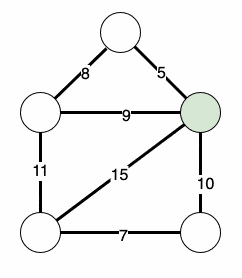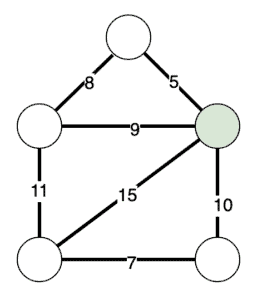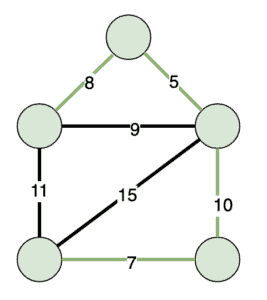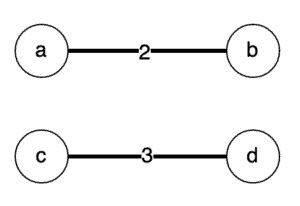1. 引言
本文将深入探讨 Prim 算法(Prim’s Algorithm),并使用 Kotlin 实现。该算法是图论中的经典贪心算法,适用于解决最小生成树问题。对于后端开发中涉及网络拓扑、路径优化等场景,掌握此类基础算法有助于更好地建模和设计系统。
2. Prim 算法原理
✅ Prim 算法是一种贪心算法,用于在带权无向图中找出最小生成树(Minimum Spanning Tree, MST)。
我们来拆解一下关键概念:
- 无向图(Undirected Graph):边没有方向,可以从 A 到 B,也可以从 B 到 A。
- 带权图(Weighted Graph):每条边都有一个权重值,通常表示成本、距离或开销。
- 生成树(Spanning Tree):连接图中所有节点的极小连通子图,且不包含环。
- 最小生成树(MST):在所有可能的生成树中,总权重最小的那一棵。
Prim 算法的核心思想是从一个起始节点出发,逐步扩展“已访问”区域,每次选择一条连接“已访问”与“未访问”节点之间权重最小的边,直到所有节点都被覆盖。
算法步骤如下:
- 随机选择一个起始节点,标记为已访问;
- 找出所有连接已访问节点与未访问节点的边中权重最小的一条;
- 将这条边加入 MST,并将新节点标记为已访问;
- 重复第 2–3 步,直到所有节点都被访问。
整个过程如下动图所示:

初始状态任意选一个节点作为起点:

最终得到的 MST 权重最低:

⚠️ 注意:Prim 算法仅适用于连通图。若图不连通,则无法构造出覆盖所有节点的生成树。
3. Kotlin 实现
接下来我们将用 Kotlin 完整实现 Prim 算法。代码结构清晰,适合集成到实际项目中进行图分析。
3.1 图的数据结构设计
首先需要定义图的基本组成单元:边(Edge) 和 图(Graph)。
节点用 String 类型表示(可视为 ID),实际项目中可根据需求替换为更复杂的类型。
data class Edge(
val first: String,
val second: String,
val weight: Int
)
图由一组边构成:
data class Graph(val edges: Collection<Edge>)
✅ 踩坑提醒:这种设计无法表示孤立节点(无边的节点),但 MST 本身也不包含孤立点,因此不影响算法逻辑。
添加两个辅助方法,便于后续操作:
- 获取图中所有节点:
fun getNodes(): Collection<String> {
return edges.flatMap { setOf(it.first, it.second) }.distinct()
}
- 获取与指定节点相连的所有边:
fun getEdgesForNode(node: String): Collection<Edge> {
return edges.filter { it.first == node || it.second == node }
}
3.2 初始化算法环境
Prim 算法主函数签名如下:
fun prims(graph: Graph): Graph
返回一个新的 Graph,其 edges 字段仅包含 MST 中的边。
初始化两个核心集合:
val visitedNodes = mutableSetOf<String>()
val edges = mutableSetOf<Edge>()
任选一个起始节点(这里随机选取):
visitedNodes.add(graph.getNodes().random())
💡 提示:你也可以固定选第一个节点,比如
.first(),效果相同。
3.3 核心循环:边的选择逻辑
这是算法最核心的部分。循环条件是:只要还有未访问的节点,就继续执行。
while (!visitedNodes.containsAll(graph.getNodes())) {
val nextEdge = visitedNodes
.flatMap { graph.getEdgesForNode(it) } // 获取所有邻接边
.filter { !visitedNodes.contains(it.first) || !visitedNodes.contains(it.second) } // 至少一端未访问
.minByOrNull { it.weight } // 取权重最小者
// ❌ 如果找不到合法边,说明图不连通
if (nextEdge == null) {
throw IllegalStateException("无法构建生成树:图不连通")
}
// 更新状态
visitedNodes.addAll(setOf(nextEdge.first, nextEdge.second))
edges.add(nextEdge)
}
✅ 使用
minByOrNull替代minBy更安全,避免NoSuchElementException。
最后返回结果:
return Graph(edges)
完整函数如下:
fun prims(graph: Graph): Graph {
if (graph.edges.isEmpty()) return Graph(emptySet())
val visitedNodes = mutableSetOf<String>()
val mstEdges = mutableSetOf<Edge>()
visitedNodes.add(graph.getNodes().random())
while (!visitedNodes.containsAll(graph.getNodes())) {
val candidateEdges = visitedNodes
.flatMap { graph.getEdgesForNode(it) }
.filter { edge ->
!visitedNodes.contains(edge.first) || !visitedNodes.contains(edge.second)
}
val nextEdge = candidateEdges.minByOrNull { it.weight }
?: throw IllegalStateException("图不连通,无法生成最小生成树")
mstEdges.add(nextEdge)
visitedNodes.addAll(setOf(nextEdge.first, nextEdge.second))
}
return Graph(mstEdges)
}
4. 测试验证
我们使用以下图结构进行测试(节点已标注):

构建对应的 Graph 实例:
val graph = Graph(setOf(
Edge(first = "a", second = "b", weight = 8),
Edge(first = "a", second = "c", weight = 5),
Edge(first = "b", second = "c", weight = 9),
Edge(first = "b", second = "d", weight = 11),
Edge(first = "c", second = "d", weight = 15),
Edge(first = "c", second = "e", weight = 10),
Edge(first = "d", second = "e", weight = 7)
))
调用算法:
println(prims(graph))
输出结果:
Graph(edges=[
Edge(first=a, second=c, weight=5),
Edge(first=a, second=b, weight=8),
Edge(first=c, second=e, weight=10),
Edge(first=d, second=e, weight=7)
])
✅ 总权重为 5 + 8 + 10 + 7 = 30,确实是该图的最小生成树。
5. 不连通图的处理(边界情况)
如果输入的是非连通图(Disjoint Graph),例如:

val graph = Graph(setOf(
Edge(first = "a", second = "b", weight = 2),
Edge(first = "c", second = "d", weight = 3),
))
运行 prims(graph) 会抛出异常:
IllegalStateException: 图不连通,无法生成最小生成树
✅ 原因:当从
"a"和"b"出发后,再也找不到通往"c"或"d"的边(因为不在同一连通分量)。此时candidateEdges为空,minByOrNull返回null,触发异常。
📌 建议做法:
- 在调用前先判断图是否连通;
- 或者改造成支持森林(Multiple MSTs)的形式,但这超出了 Prim 算法的标准定义。
6. 总结
Prim 算法以其简洁性和高效性,在最小生成树问题中占据重要地位。通过本文的 Kotlin 实现,我们不仅掌握了其工作原理,还注意到了以下几个关键点:
- ✅ 算法基于贪心策略,每步局部最优 → 全局最优;
- ✅ 数据结构设计要便于快速查找邻接边;
- ✅ 必须处理图不连通的情况,避免运行时崩溃;
- ✅ 使用
minByOrNull比minBy更健壮; - ✅ 适合中小规模稠密图,稀疏图推荐 Kruskal 算法配合并查集。
🎯 应用场景举例:
- 网络布线成本最小化
- 城市间道路规划
- 集群合并策略(如某些机器学习算法)
所有源码已托管至 GitHub:https://github.com/Baeldung/kotlin-tutorials/tree/master/kotlin-algorithms
建议动手实践一遍,加深理解。这类基础算法虽不常手写,但在系统设计面试和复杂问题建模中极为有用。